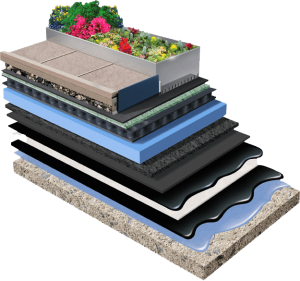With the boom of being eco-friendly, bee-friendly and using sustainable practices in everyday life. The use of vegetative roofing is something that more industrial, commercial, manufacturing and even residential property owners are exploring.
Depending on the structure of the building, you can install grass, bushes, flowers, trees or even fruits and vegetable plants! If the roof is accessible, pavers can be added as walkways and tables to expand the usable space for tenants.
But is it all flowers and sunshine?
At West Roofing Systems, we want to make sure that our future clients have the best information available. For this reason, we created an article that explores the potential problems you can have with a vegetative roofing system to give you all the information you need in choosing which roof is the best fit for your facility.
The Basics: What is Vegetative Roofing
Vegetative or “Green” Roofing is when plants are installed over the weatherproofing layer on a commercial roof. This could be in conjunction with pathways and areas for people, or it could just be an environmental/sustainable push from a company.
If a facility can have a vegetative roof installed, it means that the substrate is durable and probably made of concrete. If not, the substrate needs to be reinforced to handle the weight and traffic of the green roof.
A Green Roof installation starts with a waterproof membrane. After the substrate is reinforced and the waterproofing membrane is installed, there are two options for how your vegetation is installed.
- Tray Systems – The plants, or other vegetation, are planted in lightweight trays that are brought up to the roof. These tray systems can be interconnecting and specialized edges and can be concealed to create a seamless look.
- Layered Systems – The second option to install vegetation on a facility roof is with a layered system; layered systems are installed directly onto the roof surface.
Read More: Green Vegetative Roofing: Installation and Performance
Problems with Green Commercial Roofing
Roof Maintenance
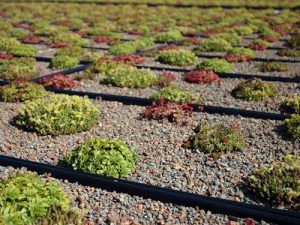
When you have a layer of vegetation, what happens when maintenance needs to be performed on the membrane underneath? Access to the substrate, insulation or waterproof membrane can be a big problem when you need to move heavy trays of vegetation or dig through layers of plants and soil.
Solution: There is no evidence that a properly installed and maintained vegetative roof will cause damage to the underlying roof system. The first insulation and membrane installation should be performed by an appropriately licensed contractor and installed correctly. The vegetative roof design plan should include the considerations of the removal of the vegetation to maintain the system underneath.
You can further protect your roof with regular maintenance including:
- Clean and unclogged drains
- Functioning irrigation systems
- Replacing any rust or damaged pieces of the roof system quickly
Unwanted Wildlife and Insects
If you have cared for a garden, you know that you get more than flowers, you get all of those that live on and with the vegetation. Since the vegetation is not growing in the ground, and usually on a high roof, burrowing and larger animals will probably not be a problem. But bugs and birds could be drawn to your gardens or public areas.
Solution: By keeping any public areas clear of trash and leftover food, you can avoid birds gathering on your green roof. As for bugs, it would be best to hire or assign someone with the responsibility to keep your roof clear of nests and to perform regular maintenance with your vegetation.
Added Weight
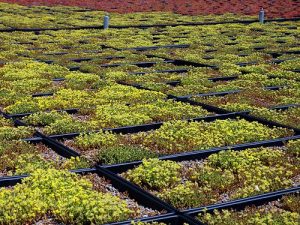
In addition to the traditional weight of a waterproof roof system, you can add 10 – 50 pounds per square foot when you add in the soil, retained water, vegetation, walking paths and even people. This added weight could stress the structure of your building and create underlying damage to your facility.
Solution: Work with your architect or a building inspector to ensure that you are making the right choices for your vegetative roof. Luckily, you have many options when it comes to the types of traffic, vegetation, and installation. You can make smart decisions such as choosing heavy vegetation over internal support structures and lightweight vegetation in other areas.
Upkeep
Every commercial roof should be maintained regularly, but not every roof needs to be watered. When you have living vegetation on your roof, you have year-round care depending on your climate. From watering to pulling weeds, there is more work to maintain a vegetative roof.
Solution: If you have a healthy budget for your vegetative roof system, you can consider hiring a contractor the specializes in vegetative roof installation and care. Having one contact for your entire roof system is easy as a property owner/manager. For the more budget conscious projects, choosing a simple system that has easy upkeep that an in-house employee can manage, could save you money in the long run.
Why Green Commercial Roofing?
There are many reasons that building owner would choose to install vegetative roofing on their facility. Whether you are renting out space in your building or you own your building, installing a vegetative roof could bring in more money through higher prices or increased productivity.
- Expand Usable Space
- Upgrade Facility Aesthetics
- Employee Wellness/Satisfaction
- Environmentally Friendly and Sustainable
Alternatives to Green Roofing
Spray Polyurethane Foam Roofing
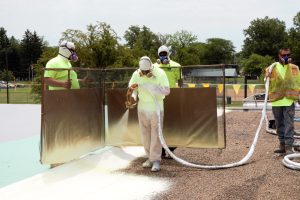
Spray Polyurethane Foam, more commonly referred to as SPF, is a liquid that is sprayed on the existing roof and expands into a foam, creating a solid layer across an existing roof.
While SPF roofing is not the most known type of roofing material, the technology has been around since the early 1960s for industrial, commercial, and residential facilities.
Read More: Spray Polyurethane Foam (SPF) Roofing: Installation & Performance
Single-Ply Membrane Roofing
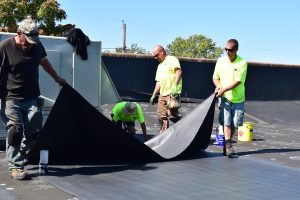
Single-Ply Membranes are sheets of rubber and other synthetics that can be chemically adhered to insulation or ballasted creating a layer of protection on your commercial facility.
There are two main types of single-ply membrane commercial roofing: Thermoplastic Polyolefin (TPO) and Ethylene Propylene Diene Terpolymer (EPDM). They differ in their chemical makeup, how they are installed and the energy efficiency.
Read More: Single-Ply Membrane Roofing: Installation & Performance
Vegetative roofing is not a typical roof type for commercial, industrial and manufacturing facilities. If your facility can host vegetation, it is an excellent option for tenant/employee morale, while giving back to the environment.
West Roofing Systems, Inc. installs sustainable and efficient roofing systems for commercial, industrial, manufacturing and municipal buildings. In over 37 years, we have installed over 56,000,000 square feet of commercial Spray polyurethane foam (SPF), single ply membrane and other popular roofing systems.
Is your roof not suitable for green roofing? Read about the most common commercial roofing to start your project.
Read More:


